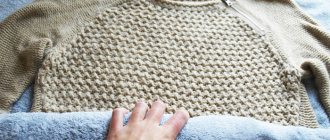- What fabrics shrink after washing?
- How to prevent clothes from shrinking after washing
- What to do if clothes shrink after washing
Shrinkage is typical for clothes made from natural materials. Any natural fibers change their properties, swell and twist after washing.
Knowing that natural fabrics shrink when wet, manufacturers take this feature into account during production, leaving the necessary allowance for the product to shrink. This should be taken into account when choosing clothes: you should not take things made of natural cotton, viscose and linen that fit snugly; the item should be a little loose.
In order to understand the reason for the deformation of the canvas after exposure to moisture, it is necessary to know the composition of the material. Any fabric consists of a weft and a warp. The warp threads are parallel to each other, and the weft threads are woven into them and intertwined with each other. The density of the fabric depends on how far apart the threads are located.
There are several main reasons why clothes shrink after washing:
- Elastic deformation. In order for the scattered threads to become a piece of fabric, a huge amount of work is carried out. The fibers are processed, bent and stretched many times, so they remain in “tension”. When water gets on them, the threads “relax” and the clothes shrink. Most often, shrinkage after washing occurs along the warp threads, the weft fibers undergo elastic deformation less often.
- Swelling of fibers. Threads made from natural materials are porous and hygroscopic. This means that they are able to absorb moisture and increase in size. If the fabric is not dense, then there are gaps between the threads that fill when it swells. In materials of medium and high density, deformation can occur due to a sharp increase in specific density. In simple terms, the swollen fibers do not have enough space and become intertwined and twisted with each other.
Proper care of the fabric will ensure long life and excellent appearance of things. Always pay attention to the symbols on the label. These pictograms will tell you whether clothes or bed linen can be washed in a machine, at what temperatures, at what speed they can be wrung out and how to dry them properly. Washing at temperatures higher than recommended and excessively curling can cause clothing to shrink a size or several.
Clothes shrink the least when washed by hand. You should choose this one if there are few things or the dirt is small. Soak the product in slightly warm water and rinse. Squeeze a little with your hands or let the excess liquid drain on its own. Depending on the composition of the fabric, choose horizontal or vertical drying.
Why do tissues become deformed?
Shrinkage is a change in the size of fabric after improper washing and drying, excessive steam and heat treatment. Your favorite sweater can easily shrink by a couple of centimeters if you do not follow the instructions for caring for it. The labels on clothes are sewn on for a reason - they tell you how to properly wash, dry and iron the item.
So why can any textile shrink in principle? The fact is that fabric is formed by weaving fibers together. The susceptibility of a material to deformation is influenced by the origin of the fibers and the method of weaving. For example, both satin and denim are made from cotton, and these are completely different products, subject to “shrinkage” to varying degrees.
Today, two types of fibers are used in production: synthetic and natural. The first ones are created on the basis of oil. Artificial polymers practically do not compress; organic threads are another matter. Natural fabrics are elastic; their weave is much looser, which leads to stronger stretching. This is how the structure of the material changes, the thing is deformed.
It is important to follow the manufacturer’s recommendations, wash and iron products according to the rules, without violating the maximum permissible temperatures.
Anti-shrink treatment methods
They try to prevent shrinkage and deformation of fabrics or, at least, reduce them in the stages prior to sewing clothes. There are special methods for this:
- mechanical. An elastic band is placed on the fabric and pressed tightly. In this form, the material is rolled through hot rollers. As a result, the tension is removed from the tape, and the fabric undergoes forced shrinkage;
- chemical. Its essence lies in the preliminary impregnation of the fibers with a solution of formaldehyde, which reduces their swelling when exposed to moisture, and consequently, deformation;
- tracking. This method is most often used for knitted materials. Rolls of fabric are laid out on shelves in a room with a given humidity and left for a long time. After the shrinkage process is completed, the canvases are put into production.
The most effective methods of anti-shrink treatment include heating with dry steam and decating. Let's learn about this method in more detail.
How much do different fabrics shrink?
If we talk about cotton-based fabrics, shrinkage sometimes reaches 3-5%, it all depends on the density and method of weaving. Corduroy, cotton wool and plaid are the ones that “shrink” the most. Chintz, percale, satin, denim, voile, poplin and other materials made from cotton fibers are slightly less deformed. Linen and mixed fabrics lose up to 6% after washing. The more cotton and linen added, the more the material can shrink.
Wool can shrink by 1.5-3.5%. Moreover, these values are typical for both drape and thin woolen materials. In some sources you can find other figures – up to 6%. This shrinkage is also typical for wool blend fabrics.
Fabrics made from natural and artificial silk are also subject to shrinkage. For example, crepe made from organic silk can lose up to 5% after washing, and from artificial silk – up to 7%. Satin fabrics are deformed by 3.5-5% of the original size. Viscose can shrink by 4%, nylon - up to 1.5%, semi-nylon - up to 3.5%. Lining materials can also change in size: non-woven fabric, dubbing, etc.
General Tips
You can reduce the size of clothes effectively and save money in a regular washing machine. Whether it is a shirt or a pair of denim trousers, the procedure can be equally successful and a person can get the size he needs without spending money on a tailor. But not every washing option may be suitable. To understand how to wash clothes so that they shrink, you need to know a few rules. Different materials shrink differently, so different methods must be used to shrink an item one or more sizes.
Before starting the procedure, you need to carefully examine the tags sewn to the back of the product and determine the material from which the item is made. For example, cotton shrinks the best, polyester shrinks the least, while leather and fur do not shrink at all. You also need to determine whether the material has been pre-soaked or pre-shrinked, as this will make it much more difficult to shrink in size by washing.
You can also use the tag to find out the recommended washing temperature. For example, wool should be washed at 40°C. It should be taken into account that the recommended temperature is also related to the durability of the textile paint. Because of this, after the procedure, the color of the clothing will be less bright. To soften the effect of fading, it is better to choose a powder for colored fabrics that prevents discoloration as much as possible. A pinch of salt will also help prevent fabric discoloration.
We return items to original size
What to do if the item has changed in size? Will it be possible to return your favorite sweater or T-shirt to its original shape, or will you have to throw out the clothes? Stretching the material back is not as difficult as it might seem. To restore a product that has shrunk after improper washing, you will have to spend a little free time. There are several options, you can try each and find a winning path. Let's look at eight ways to restore tissue.
- If after washing the woolen product “shrinks”, you should soak it in ice water for 15 minutes. Then you need to take out the item, shake it to remove excess water, and lay it out on a horizontal surface. You cannot twist the wool; the fabric may become even more deformed. You can manually stretch the item to give it the desired shape. It is better to periodically adjust the material if it returns to a shrunk position.
- After a “session” in cold water, you can not put a sweater or T-shirt to dry, but immediately put it on yourself. Therefore, if you have the opportunity to walk around in wet clothes, take advantage of it. Then the thing after drying will be just the perfect size.
- Popular advice is to add two or three tablespoons of hydrogen peroxide to the water and soak the shrunken item in the resulting solution for a couple of hours. After this, you cannot wring out silk or woolen items - you should simply lay them out on a terry towel, which will absorb excess moisture.
- A synthetic or combined jacket (skirt, T-shirt) can also be restored. You need to put the product in cold water for half an hour, and then wash it in the machine using the delicate or manual mode. The water should warm up to 20-30 degrees, no more. It is also important not to put washing powder into the machine.
- Cotton items can be easily stretched with vinegar solution. You should take a clean cloth, soak it in vinegar, and “walk” the cloth over the cloth. The clothes are then hung on a line so that weights can be attached to the bottom. This way the material will straighten to the desired size.
- There is another option using vinegar. You need to pour 3 tablespoons of acid into a basin with ten liters of water, mix everything well. Soak things in this container for 20-25 minutes. Afterwards, the clothes are hung to dry on the balcony or in a well-ventilated room.
- Silk fabric can be stretched not by cold, but, on the contrary, by high-temperature methods. What to do? You should soak the silk in cool water, lightly wring out the product and iron it with a hot iron. During the ironing process, you can stretch the material to the sides to the desired size.
- If the manufacturer prohibits ironing the item, try stretching it with steam. Clothes are also first soaked in cold water and then steamed.
There are several technologies that allow you to correct the situation and give things their original form. Choose the optimal method, focusing on the fabric composition, recommendations and prohibitions of the product manufacturer. However, in any case, it is better to prevent shrinkage by taking preventive measures when washing.
If your shirt, T-shirt or jeans shrink after washing
Denim and cotton fabrics are also prone to warping. However, restoring damaged pants, a T-shirt or shirt is also not difficult. To do this you will need to prepare a vinegar solution. Use the following dosage: two tablespoons of acetic acid per liter of water. Pour the prepared mixture into a small container. Place shrunken clothes on the table. Then soak a sponge in the mixture. Treat the fabric while stretching the product. After the manipulations, let the product dry. To eliminate the unpleasant smell of vinegar, you will need to rinse the product with conditioner. While the pants are drying, periodically stretch the fabric.
To restore the shape of the shirt, you can soak it in the same solution. Just use this proportion: 25 ml. vinegar per 2 liters of water. The duration of the procedure is 30-40 minutes.
Why do decatification?
For many, the word decatification is unfamiliar. In fact, this is a kind of forced shrinkage of the fabric from which it is planned to be sewn. Before cutting the material, it is subjected to wet-heat treatment - this is an integral stage of quality control of the future product. Any fabrics consisting of 50 percent or more natural fibers (wool, cotton, linen, hemp, silk) are decatified. Tests are carried out under conditions that comply with the recommendations on product labels.
All fabrics used for sewing items that are planned to be washed must be decated.
Decating of the material is not done before sewing, for example, a coat. If in the future only dry cleaning is allowed for an item, then simply steam the fabric with an iron before cutting.
So, cotton and linen are soaked, dried and ironed while still wet. The same is done with silk fabrics, however, they are “passed” over them with a slightly warm iron, from the wrong side. Silk that is subject to shedding is covered with a wet sheet and then ironed. Thick woolen fabrics are moistened with a spray, then the material is left to rest for 8-10 hours. Next, the fabric is ironed from the wrong side. Thin wool fabrics should simply be ironed through a damp sheet.
Thus, absolutely any thing can “sit down”. To prevent this from happening, it is important to follow the care instructions on the product label. If shrinkage does occur, you can correct the situation. Try stretching the item with your own hands, choosing one of the available methods.
Interesting:
- Washing an acrylic sweater in a washing machine
- What to do if your T-shirt shrinks after washing?
- What to do if the dress shrinks after washing?
- Woolen item shrunk after washing
- Washing corduroy trousers in the washing machine
- Washing knitted items in the washing machine
Reader comments
- Share your opinion - leave a comment
How to fix?
If a woolen item has shrunk, you can try to save it. When choosing a method, it is worth considering a number of key factors in order not to completely ruin your clothes:
- Initially, you can re-wash only by hand.
- Use only cool water.
- To make the fabric softer, use conditioner during the rinsing process; it is better to choose a special one for wool.
- When drying horizontally, stretch the sleeves at the same time, making sure they are the same.
- To wring out, use terry towels.
Even synthetics will become soft
Many synthetic fabrics have properties that can be safely put on the same scale as natural ones. This is about technical characteristics. And if we talk about the possibilities of creating a unique design, then sometimes they have no equal. All girls now sew dresses and skirts from neoprene, they are at the peak of popularity.
Your wardrobe probably contains clothes made from materials that contain unnatural fibers:
- factory lace;
- taffeta;
- organza;
- chiffon;
- crepe de Chine;
- footer;
- Jersey.
One way or another, things made from synthetic fabrics have firmly entered our lives, so it is necessary to know how to handle them in order to ensure comfortable wearing.
To make this material soft, you need to use a conditioner and be sure to follow the rules indicated on the clothing label. Some housewives use vinegar or prepare the mixture themselves. But why resort to such methods if specialized products are sold in stores.











